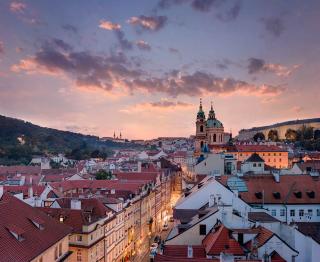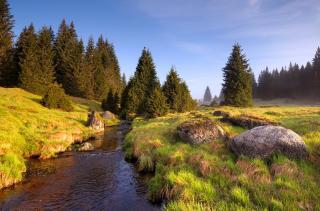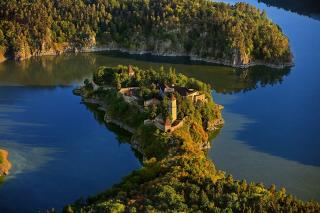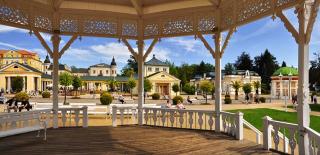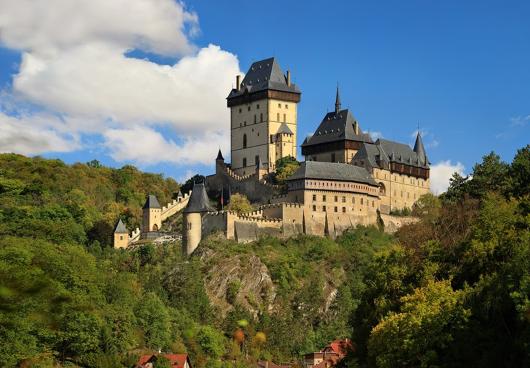
Tourism
The Czech Republic is a country of great historical and cultural importance, a country where historic monuments and entire towns have been included on the World Heritage List.
The main popular tourist destination in the Czech Republic is, of course, the country´s capital Prague. The city is generally considered to be one of the most beautiful world capitals with a uniquely preserved historical center. Many other Czech towns and historic monuments, however, are well-preserved and are listed in the UNESCO register as world cultural landmarks. Further, the Czech Republic has been well-known for its curative mineral spas, over 2.000 castles and palaces and for being an active holiday destination.
Prague
The historical centre of Prague covering an area of 866 hectares was listed in the UNESCO World Cultural and Natural Heritage Register in 1992. Prague has always played an important role in the history of the nation, the country and the whole of Europe. It has cherished a reputation of one of the most beautiful cities in the world and has been paid tribute by many outstanding personalities.
Selected Distances:
Prague |
- Berlin - Paris - London - New York |
282 km 864 km 1,030 km 6,561 km |
- Moscow - Warsaw - Budapest - Istanbul |
1,665 km 512 km 457 km 1,504 km |
Useful websites:
Prague City Tourism
Historic Center of Prague
Prague.eu
Prague events information
UNESCO World Heritage Monuments
The list of sights inscribed in the World Heritage List:
Historic Centre of Prague
Historic Centre of Český Krumlov
Historic Centre of Telč
Pilgrimage Church of St. John of Nepomuk at Zelená Hora
Kutná Hora: Historical Town Centre with the Church of Saint Barbara and the Cathedral of our Lady at Sedlec
Lednice-Valtice Cultural Landscape
Holašovice Historical Village Reservation
Gardens and Castle at Kromeříž
Litomyšl Castle
Olomouc - the Column of the Holy Trinity
Třebíč - Historical Center
Principle mountain ranges
Krkonoše (Giant Mountains )
The Krkonoše range stretches 40km into Bohemian territory, creating a natural border between the Czech Republic and Poland, and is the Czech Republic´s highest mountain range. The highest peak is Mt. Snezka (1,602 m). Several other peaks exceed 1,500 m. In order to preserve both wildlife and the environment, the Krkonoše was proclaimed a national park in 1963.
Hrubý Jeseník (Ash Mountains)
The Hrubý Jeseník is the second highest mountain range in the Czech Republic, and its highest point is Praded Peak (1,491 m). Located in northern Moravia, this range is similar in character to the Krkonoše and has been a protected region since 1969.
Šumava (Bohemian Forest)
The third highest mountain range in the Czech Republic, the Šumava´s highest point is Plechý Peak (1,373 m). The Šumava extends 125 km into south-western Bohemia from the border and creates a natural boundary with Germany. Five limestone lakes found here are of glacial origin. The Black Lake is the largest (18.61 hectares). The Šumava has been a protected region since 1962 and was declared a national park in 1991. This region is also protected on the German side where it becomes The Bavarian Forest National Park.
Beskydy
The Morava-Silesian Beskydy Mountains are situated in the eastern part of the Czech Republic in northern Moravia. The area shares borders with Poland to the north and with the Slovak Republic to the east. The Beskydy Mountains are part of a frontier mountain range that runs from north to south, with the highest points over 1000 m above sea level. Its landscape of long, rolling hillsides is covered with forests and pastures. The terrain is ideal for hiking, cross-country skiing and mountain biking.
Lakes and rivers
The Czech Republic is called the roof of Europe since its only source of water is atmospheric rain and snowfall. All the rivers which have their source in the area drain into neighbouring countries.
The Czech Republic has three river basins:
The Labe (Elbe) River Basin (drains into the North Sea) - 51,399 sq.km. Main rivers: Labe, Vltava
The Odra (Oder) River Basin (drains into the Baltic) - 4,721 sq.km. Main rivers: Odra, Opava, Ostravice and Olše
The Dunaj (Danube) River Basin (drains into the Black Sea) - 22,744 sq. km. Main rivers: Morava, Dyje
The river basins intersect at Kralický Sněžník on the Polish border.
There are 455 natural lakes in the Czech Republic, 350 of which are river lakes that have formed in the grasslands of larger rivers. A characteristic feature of the Czech landscape is the large number of artificial lakes created for fish-farming. They number 21,800 in total and cover about 41,000 hectares. The largest of them are Lake Rozmberk and Lake Bezdrev in southern Bohemia.
Mineral waters and spas
The abundance and quality of mineral springs in the Czech Republic makes the country a world leader in this area. Many large and renowned spas have been founded around natural or drilled mineral water springs, including the spa in Karlovy Vary, as well as in Mariánské Lázně, Františkovy Lázně, Poděbrady, Luhačovice, Jáchymov, and many others which are smaller but still therapeutically important. The warmest Czech springs include the famous Thermal Spring in Karlovy Vary (72oC), and springs in Teplice (42oC) and Janské Lázně (29.6oC). The waters from former uranium mines in Jáchymov have the highest radioactivity in the world (5,085 Mach units, .08 oz.Rn/gal.)
Karlovy Vary are the best known and largest spa in the Czech Republic. It is world famous for its hot mineral springs and mineral salts. The place has a very long history and today it presumably i sthe second most visited town in the Czech Republic after Prague.The healing sources are rare hydrocarbonate-sulfur-chloride and hydrocarbonate-sodium-calcium thermal mineral waters.World famous liqueur Becherovka is also produced in Karlovy Vary.
Marianské Lázně
The second most important spa in the Czech Republic situated in West Bohemia. The first written record of this spa comes from 1528. Many famous writers, composers, poets and philosophers spent their time in this picturesque town and enjoyed the beautiful landscape around.
Luhačovice is the biggest spa in Moravia with the tradition of more than 300 years of spa treatment, based on the curative power of the natural mineral springs.
Treatment of locomotive apparatus and nervous system belong to the main specialization of this spa. Except conditions after injuries and surgeries they treat cardiovascular diseases and burns. Natural curative source - iodine-bromine brine and modern rehabilitation are an ideal combination of effective treatment. In addition to curative stays, the spa offers relaxing stays and procedures for everybody.
Klímkovice Spa has been providing its clients with superior rehabilitation since 1994. For anyone who wants to improve their job performance or suffers from health problems, particularly with locomotor apparatus, the spa has prepared a variety of therapeutic and preventive programs.
The spa offers experience, tradition, high success rate in the treatment of the musculoskeletal system, specialization in treatment of muscles, ligaments, conditions after musculoskeletal system surgeries, hip replacement surgeries, after injuries, phlebitis and lymphatitis, inflammatory and degenerative disorders, vertebrogenic syndromes, and diabetes-related circulatory and nervous system disorders.





